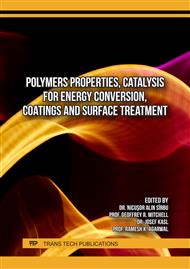[1]
I., D., Utu., G., Marginean., Iosif, Hulka., Viorel, Aurel, Şerban., Daniel, Cristea, Properties of the thermally sprayed Al2O3–TiO2 coatings deposited on titanium substrate, Int. J. Refract Met H. 51 (2015) 118-123.
DOI: 10.1016/j.ijrmhm.2015.03.009
Google Scholar
[2]
Filofteia-Laura, Toma., Carl, Christoph, Stahr., Lutz-Michael, Berger., S., Saaro., Mathias, Herrmann., D., Deska., G., Michael, Corrosion Resistance of APS- and HVOF-Sprayed Coatings in the Al2O3-TiO2 System. J. Therm. Spray Techn. 19 (2010) 137-147
DOI: 10.1007/s11666-009-9422-2
Google Scholar
[3]
Thankam, Sreekumar, Rajesh., Ravipudi, Venkata, Rao, An Experimental Investigation into the Amalgamated Al2O3-40% TiO2 Atmospheric Plasma Spr.ay Coating Process on EN24 Substrate and Parameter Optimization Using TLBO. J Mater. Sci. & Chem. Eng. 4 (6), (2016).
DOI: 10.1016/j.matpr.2017.12.079
Google Scholar
[4]
James, W., Murray., Andrew, Siao, Ming, Ang., Zdenek, Pala., E., Shaw., Tanvir, Hussain, Suspension High Velocity Oxy-Fuel (SHVOF)-Sprayed Alumina Coatings: Microstructure, Nanoindentation and Wear. J. Therm. Spray Techn. 25(8) (2016) 1700-1710
DOI: 10.1007/s11666-016-0462-0
Google Scholar
[5]
Vairamuthu, Raj., Mohamed, Sirajudeen, Mumjitha, Formation and surface characterization of nanostructured Al2O3-TiO2 coatings, B. Mater. Sci. 37 (2014) 1411-1418
DOI: 10.1007/s12034-014-0090-6
Google Scholar
[6]
Erja, Turunen., Tommi, Varis., Tom, E., Gustafsson., Jari, Keskinen., Pertti, Lintunen., Teppo, Fält., Roman, Nowak., Simo-Pekka, Hannula, Process optimization for nanostructured HVOF-sprayed Al2O3-based ceramic coatings. Key Eng. Mat., 317-318 (2006) 545-548
DOI: 10.4028/www.scientific.net/kem.317-318.545
Google Scholar
[7]
Xuesong, Fu., Jiulun, Fan., Wu, Yunhua., Xuechou, Zhou., Liu, Zengfu., Wang, Shouzhen., Baoyu, Gao, Comparative Study of Wc-20cr3c2-7ni and Al2o3-Tio2 Ceramic Coatings Prepared by HVOF or Aps Technology on the Salt Spray Corrosion (2024)
DOI: 10.2139/ssrn.4715836
Google Scholar
[8]
Markus, Sauter., Venancio, Martínez, García., Andreas, Killinger, HVSFS Al2O3-TiO2 Coatings of Porous Aluminium Substrates, Therm. Spray Proc. itsc2022p0596 (2022) 596-600
DOI: 10.31399/asm.cp.itsc2022p0596
Google Scholar
[9]
Khushneet, Singh., Mir, Irfan, Ul, Haq., Sanjay, Mohan, Tribological Behavior of Novel Al2O3-La2O3 HVOF Composite Coatings, Tribol. Int. 193 (2024) 109427
DOI: 10.1016/j.triboint.2024.109427
Google Scholar
[10]
Monika, Michalak., Leszek, Latka., Paweł, Sokołowski., Filofteia-Laura, Toma., Hanna, Myalska., Hanna, Myalska., Alain, Denoirjean., Hélène, Ageorges, Microstructural, mechanical and tribological properties of finely grained Al2O3 coatings obtained by SPS and S-HVOF methods, Surf. Coat. Tech., 404 (2020) 126463
DOI: 10.1016/j.surfcoat.2020.126463
Google Scholar
[11]
Zhou, Jingzhong., Sun, Kuoteng., Huang, Songqiang., Cai, Weichen., Yangzhi, Wei., Liang, Meng., Zhaowei, Hu., Wenge, Li., Fabrication and Property Evaluation of the Al2O3-TiO2 Composite Coatings Prepared by Plasma Spray, Coatings 10(11) (2020) 1122
DOI: 10.3390/coatings10111122
Google Scholar
[12]
Alexei, Richter., Lutz-Michael, Berger., Yoo, Jung, Sohn., Susan, Conze., Kerstin, Sempf., Robert, Vaßen, Impact of Al2O3-40 wt.% TiO2 feedstock powder characteristics on the sprayability, microstructure and mechanical properties of plasma sprayed coatings, J. Eur. Ceram. Soc., 39(16) (2019) 5391-5402
DOI: 10.1016/j.jeurceramsoc.2019.08.026
Google Scholar
[13]
Leszek, Łatka., Aneta, Niemiec., Monika, Michalak., Paweł, Sokołowski, Tribological Properties of Al2O3 + TiO2 Coatings Manufactured by Plasma Spraying, Tribologia 283(1) (2019) 19-24
DOI: 10.5604/01.3001.0013.1431
Google Scholar
[14]
N, K, Mishra., S, B, Mishra, Hot corrosion performance of LVOF sprayed Al2O3 –40% TiO2 coating on Superni 601 and Superco 605 superalloys at 800 and 900°C, B. Mater. Sci. 38 (2015) 1679–1685
DOI: 10.1007/s12034-015-0986-9
Google Scholar
[15]
Pietro, Puddu., Septimiu, Popa., Giovanni, Bolelli., Peter, Krieg., Magdalena, Lassinantti, Gualtieri., Luca, Lusvarghi., Andreas, Killinger., Rainer, Gadow, Suspension HVOF spraying of TiO2 using a liquid-fueled torch, Surf. Coat. Tech. 349 (2018) 677-694
DOI: 10.1016/j.surfcoat.2018.06.062
Google Scholar
[16]
G.A., Clavijo-Mejía., D.G., Espinosa-Arbeláez., Jennifer, Andrea, Hermann-Muñoz., A., L., Giraldo-Betancur., Juan, Muñoz-Saldaña, Effect of HVOF Process Parameters on TiO 2 Coatings: An Approach Using DoE and First-Order Process Maps. J. Therm. Spray Tech., 28 (2019) 1160-1172
DOI: 10.1007/s11666-019-00895-9
Google Scholar
[17]
Satish, Tailor., Nitesh, Vashishtha., Ankur, Modi., S., C., Modi, High-Performance Al2O3 Coating by Hybrid-LVOF (Low-Velocity Oxyfuel) Process, J. Therm. Spray Tech., 29(5) (2020) 1134–1143
DOI: 10.1007/s11666-020-01033-6
Google Scholar
[18]
I, V, Blinkov., D., S., Belov., A., I., Laptev., A., S., Anikeev., V., V., Ivanov, Flame sprayed and plasma sprayed Al2O3-TiO2 coatings, Phys.: Conf. Ser. 1954 (2021) 012003
DOI: 10.1088/1742-6596/1954/1/012003
Google Scholar
[19]
Jolanta, Zimmerman, Numerical and experimental analysis of residual stresses induced in metal coatings thermally deposited (HVOF) on Al2O3 substrates. J. Theor. Appl. Mech. 54(3) (2016) 921-933
DOI: 10.15632/jtam-pl.54.3.921
Google Scholar
[20]
Ankit, Tyagi., S., M., Pandey., Ravinderjit, Singh, Walia., Qasim, Murtaza., Ajay, Kumar, Effect of Temperature on the Sliding Wear Behavior of HVOF Sprayed Al2O3 Composite Coating, Adv. in Mater. & Mech. Eng. (2021) 23-28
DOI: 10.1007/978-981-16-0673-1_3
Google Scholar
[21]
Dan A., Barshilia H.C., Chattopadhyay K., Basu B., Solar energy absorption mediated by surface plasma polaritons in spectrally selective dielectric-metal-dielectric coatings: a critical review. Renewable and Sustainable Energy Reviews, 79 (2017) 1050-1077
DOI: 10.1016/j.rser.2017.05.062
Google Scholar
[22]
Zhang K., Hao L., Du M., Mi J., Wang J.-N., Meng J., A review on thermal stability and high temperature induced ageing mechanisms of solar absorber coatings. Renewable and Sustainable Energy Reviews, 67 (2017) 1282-1299
DOI: 10.1016/j.rser.2016.09.083
Google Scholar
[23]
Salvi S.S., Bhalla V., Taylor R.A., et al., Technological advances to maximize solar collector energy output: a review. J. Electron. Packaging 140(4) (2018) 040802
DOI: 10.1115/1.4041219
Google Scholar
[24]
Xinkang D., Cong W., Tianmin W., Long Z., Buliang C., Ning R., Microstructure and spectral selectivity of Mo-Al2O3 solar selective absorbing coatings after annealing, Thin Solid Films, 516(12) (2008) 3971-3977
DOI: 10.1016/j.tsf.2007.07.193
Google Scholar
[25]
Wang XY, Gao JH, Hu HB, Zhang HL, Liang LY, Javaid K, et al., High-temperature tolerance in WTi-Al2O3 cermet-based solar selective absorbing coatings with low thermal emissivity, Nanomater Energy 11(6) (2017) 1037
DOI: 10.1016/j.nanoen.2017.05.036
Google Scholar
[26]
J. Visniakov, A. Janulevicius, A. Maneikis, I. Matulaitiene, A. Selskis, S. Stanionyte, A. Suchodolskis, Antireflection TiO2 coatings on textured surface grown by HiPIMS, Thin Solid Films 628, (2017) 190-195
DOI: 10.1016/j.tsf.2017.03.041
Google Scholar
[27]
B.S. Richards, Single-material TiO2 double-layer antireflection coatings, Sol. Energy Mater. Sol. Cells 79(3), (2003)
DOI: 10.1016/s0927-0248(02)00473-7
Google Scholar


